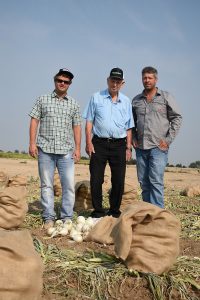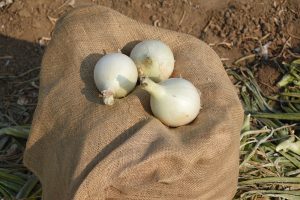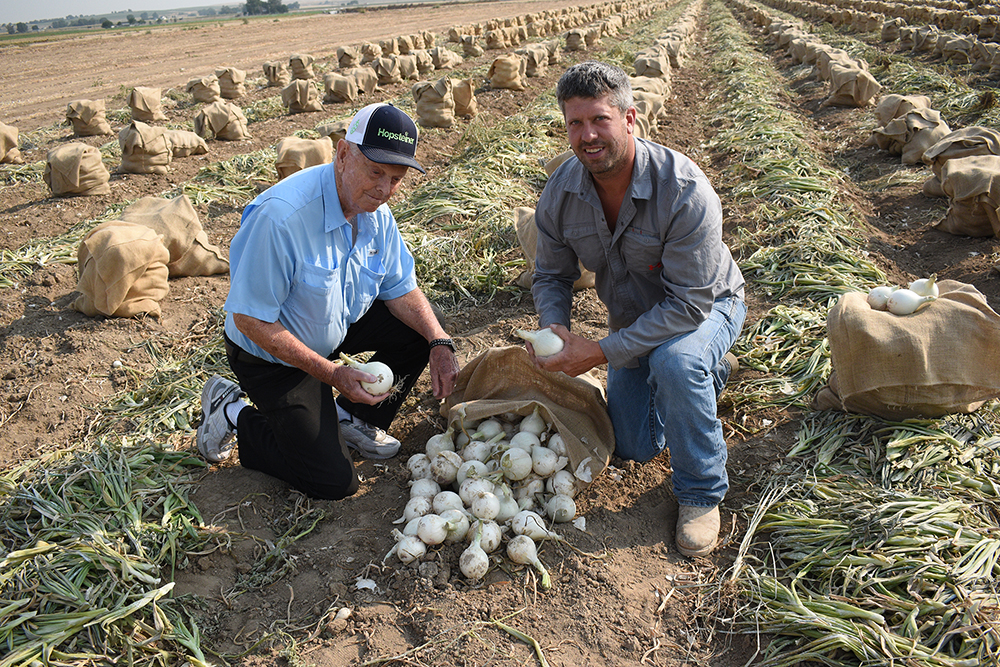Story by Denise Keller, Editor
Photos by Dave Alexander, Publisher
In 1938, Ray Obendorf, a sophomore in high school at the time, decided to grow a half acre of onions to earn some money. Little did he know then, that onions would still be in the Obendorf Farms rotation 80 years and two generations later.
Today, the Wilder, Idaho farm, now managed by his grandsons Phil and Brock Obendorf, produces 200 acres of onions. While onions make up a small percentage of the farm’s overall production, the crop plays a key role in the farm’s ability to utilize the H-2A temporary agricultural worker program.
Onions in the Off-Season
During the last decade, Obendorf Farms has decreased onion acreage by about 50 percent as the farm expanded its hops production to its current 2,600 acres with another 300-acre partnership with the Watson family. With 250 employees needed to operate the four hop-harvesting facilities, labor presents the biggest hurdle on the farm. High-paying construction jobs created by Boise’s booming housing market have consumed much of the labor pool, says Phil Obendorf.
As a result, Obendorf turned to the H-2A program in 2015. The program allows agricultural employers to hire foreign guest workers on temporary work visas to fill seasonal jobs. The farm will employ 195 workers through the program this year. The majority arrived Feb. 15 for spring and summer work, with a second crew coming Aug. 1. The first crew will go home after hop harvest, while the second group will stay until Dec. 15.
The workers stay busy in the hop fields through June and again at the end of August through September, but have some downtime in between. Obendorf uses onions and the farm’s 18-acre blueberry crop as supplemental work for the H-2A employees during the off-season. This allows the grower to hire the workers on a full 10-month program as opposed to two separate programs in the spring and fall.
“Hops are the foundation of the farm, so it establishes how much labor we require. The amount of labor we have determines how many white onions we can plant and the way that we operate all our other crops,” Obendorf explains.
Onions occupy about 20 percent of the H-2A workers’ time. The workers install and remove irrigation drip tape, pull weeds, hand-top and sack white onions, bin onions and help with planting.
The farm’s onion crop includes 100 acres of white onions, 70 acres of yellow onions and 35 acres of red onions, as well as an additional 220 acres of sharecrop onions.
Obendorf Farms began hand-sacking the white onions in 2016. The white onions are undercut during the hotter part of the growing season, whereas the reds and yellows aren’t harvested until October. Hand-topping and sacking the early-maturing white onions helps prevent sunscald, and “you get a superior product if you put them in a bag,” Obendorf says. The crew hand-tops the onions into 5-gallon buckets, which are emptied into 50-pound burlap sacks before being dumped into a truck bed, transported to a binning station and placed in storage.
H-2A Benefits, Burdens
Obendorf Farms is one of four employers in the Treasure Valley using the H-2A program, according to the grower.
“We are the pioneers of the H-2A program in the area,” he says, noting that a large onion operation and two apple growers also use the program.
Adoption of the H-2A program has brought both benefits and burdens. After experiencing a high turnover rate on crew labor, Obendorf has appreciated the stability of the H-2A workforce.
“The biggest benefit of the program is having the same people show up every day, and you don’t have to retrain new people,” Obendorf shares. “Many of the workers return each year, which is very cost effective for us. They are extremely dependable and very hardworking.”
On the flipside, the greatest challenge has been finding enough housing to accommodate the crew. The program mandates that employers provide workers with approved housing that meets requirements including a minimum square footage and proximity to a store. A local housing shortage has made this difficult.
Other expenses include transportation costs to and from Mexico, as well as wages based on the prevailing wage set by the state each year. In addition, a fulltime Obendorf Farms employee spends 90 percent of her time on H-2A paperwork.
“Anybody that is looking at the H-2A program has to have diversity in their farm to be able to justify this program because it costs so much to bring these people from Mexico. You need to have multiple jobs lined up for it to be cost effective,” Obendorf says.
The H-2A program has been a good fit for Obendorf Farms, according to the grower. Without the program, he would have to restructure the farm to include crops that are less labor intensive. He would likely still grow onions, but possibly shift acreage from whites to yellows. For now, he plans to keep acreage as is and only grow as many white onions as he has the labor to harvest.
Four-Generation Farm
In addition to onions, hops and blueberries, Obendorf Farms has 550 acres set aside for wheat and corn. Another 700 acres of grass hay and 300 to 400 acres of alfalfa are grown to feed the family’s 800-head cow and calf operation located in Jordan Valley, Oregon.
The Obendorf family has been farming in Idaho for four generations. Early crops included lettuce, and in 1948, they began growing hops. In 1961, Ray Obendorf moved his 1,300-acre row crop farm six miles north of Parma through the desert entry program and continued farming hops in Wilder. His son, Greg Obendorf, took over the operation in the early 1980s and handed over the reins to his sons, Phil and Brock, in 2008. Greg Obendorf now runs Obendorf Hops.
As for Ray Obendorf, his first half acre of onions, which he sold to JC Watson, led to a lifetime in the business. He says Watson took him under his wing and showed him the ropes. Now a spry 94, Ray Obendorf continues growing onions as a sharecropper for Obendorf Farms.




